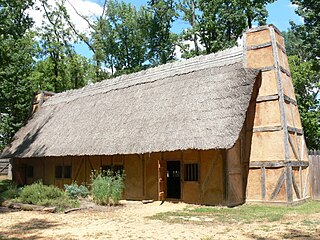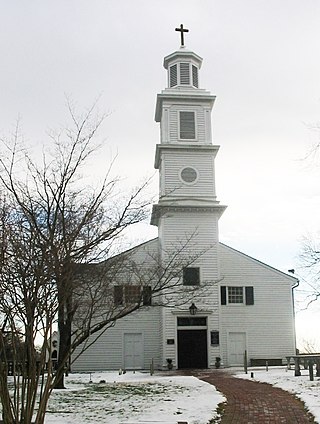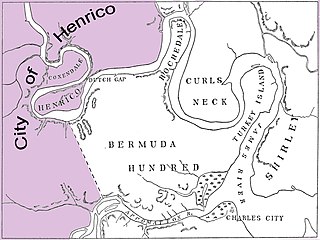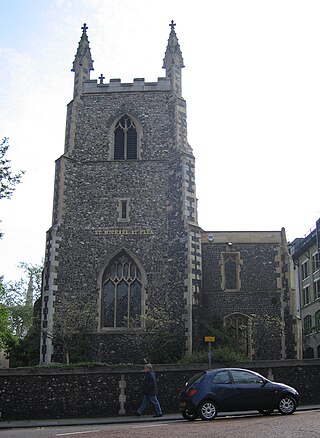Related Research Articles

The Colony of Virginia was an English, later British, colonial settlement in North America between 1606 and 1776.

The House of Burgesses was the elected representative element of the Virginia General Assembly, the legislative body of the Colony of Virginia.
Samuel Jordan was an early settler and Ancient Planter of colonial Jamestown. He arrived in Virginia around 1610, and served as a Burgess in the first representative legislative session in North America. Jordan patented a plantation which he called "Beggar's Bush", which later became known as Jordan's Journey. It became a safe haven and stronghold for settlers during the Second Anglo-Powhatan War that ensued after the Powhatan surprise attack of 1622.

Sir Thomas Dale was an English naval commander who served as deputy-governor of the Virginia Colony in 1611 and again from 1614 to 1616. Dale is best remembered for the energy and the extreme rigour of his administration in Virginia, which established order and in various ways seems to have benefited the colony, although he was criticised for high-handedness. He is also credited with the establishment of Bermuda Hundred, Bermuda Cittie, and the Cittie of Henricus.

The "Citie of Henricus"—also known as Henricopolis, Henrico Town or Henrico—was a settlement in Virginia founded by Sir Thomas Dale in 1611 as an alternative to the swampy and dangerous area around the original English settlement at Jamestown, Virginia. It was named for Henry, Prince of Wales (1594–1612), the eldest son of King James I.

St. John's Church is an Episcopal church located at 2401 East Broad Street in Richmond, Virginia, United States. Formed from several earlier parishes, St. John's is the oldest church in the city of Richmond, Virginia. It was built in 1741 by William Randolph's son, Colonel Richard Randolph; the Church Hill district was named for it. It was the site of two important conventions in the period leading to the American Revolutionary War, and is famous as the location where American Founding Father Patrick Henry gave his memorable speech at the Second Virginia Convention, closing with the often-quoted demand, "Give me liberty, or give me death!" The church is designated as a National Historic Landmark.
Christopher Branch was an early English settler in Colonial Virginia, tobacco planter, and a member and justice of the House of Burgesses. He was a three times great-grandfather of United States President Thomas Jefferson.
Thomas Graves was one of the original Adventurers (stockholders) of the Virginia Company of London, and one of the very early Planters (settlers) who founded Jamestown, Virginia, the first permanent English settlement in North America. He was also the first known person named Graves in North America. Captain Thomas Graves is listed as one of the original Adventurers as "Thomas Grave" on page 364, Records of the Virginia Company of London, vol. IV.
Elizabeth City was one of four incorporations established in the Virginia Colony in 1619 by the proprietor, the Virginia Company of London, acting in accordance with instructions issued by Sir George Yeardley, Governor. This allowed the crown to benefit from the offerings of the new land, including its natural resources, new markets for English goods, and the leverage it provided against the Spanish.

The City of Henrico is one of the oldest counties in the Colony of Virginia. It was one of four incorporations established in the colony by its proprietor, the Virginia Company. The City of Henrico, which included the settlement of Henricus, was the furthest incorporation upstream on the James River. In 1634, Henrico was reorganized under royal authority as the shire of Henrico, one of eight shires in the Crown Colony of Virginia, Later, it became known as Henrico County, Virginia.

William Moss Capps, Sr. was born in Norfolk, England in or around 1575. William married Catherine Jernagin in Norwich, Norfolk, England, 11-Dec-1596, at St. Michael at Plea. He and his wife had five children together: Henry, Frances, Willoughby, Anne, and William.
Captain Thomas Harwood emigrated from Britain and became a soldier, landowner and politician in the Colony of Virginia. He founded a family which like him for generations often represented the area now known as Newport News, but which in his day was known as Mulberry Island, and later Warwick River and still later Warwick County. Despite coming into conflict with royal governor Sir John Harvey in 1635, and a gap in legislative service, Harwood became the 5th speaker of the House of Burgesses.
Henry Soane (1622–1661) was a Virginia politician, real estate investor and landowner who served in the House of Burgesses 1652–55, 1658, and 1660–61, and was its Speaker in 1661.
William Powell, was an early Virginia colonist, landowner, militia officer and legislator. Considered an ancient planter for living in the Virginia colony during its first decade, he was one of two representatives from what became James City County, Virginia in the first Virginia House of Burgesses in 1619. His former plantation, now across the James River in Surry County, Virginia is now within Chippokes State Park.
George Thorpe, was a noted landowner, Member of Parliament, distiller, educator and major investor in early colonial companies in the Americas.
James Crewes was a British merchant who traded with the Virginia colony before emigrating there. He became a planter in Henrico County and represented it for one session of the House of Burgesses, but was executed for his participation in Bacon's Rebellion.

William Farrar was a landowner and politician in colonial Virginia. He was a subscriber to the third charter of the Virginia Company who immigrated to the colony from England in 1618. After surviving the Jamestown massacre of 1622, he moved to Jordan's Journey. In the following year, Farrar became involved in North America's first breach of promise suit when he proposed to Cecily Jordan.
William Spencer was an early Virginia colonist on Jamestown Island, who was an Ancient planter and a member of the Virginia House of Burgesses in Jamestown, Virginia for Mulberry Island in 1632/33.
William Sharpe was an early Virginia colonist, soldier, ancient planter, and Virginia Company shareholder who settled in the Bermuda Hundred area that became part of Charles City County, Virginia. He served in the Virginia House of Burgesses in Jamestown, Virginia, in 1629.
Colonel Thomas Lygon III was a Colonial Virginian statesman, militia officer, and landowner. Born into a genteel family in England, Lygon emigrated to the Virginia Colony in the early 1640s. He served in the House of Burgesses, representing Henrico County, and was a justice of the peace for Charles City County. Lygon owned large parcels of land along the Appomattox River, and worked as a surveyor until his death in 1675. He was the patriarch of the American branch of the Lygon family.
References
- ↑ McCartney, Martha W. (2007). Virginia Immigrants and Adventurers, 1607-1635 : a biographical dictionary. Baltimore, MD: Genealogical Pub. Co. p. 266. ISBN 9780806317748 . Retrieved 20 May 2016.
- ↑ James Horn (2008). A Land As God Made It: Jamestown and the Birth of America. Basic Books. pp. 189–. ISBN 978-0-7867-2198-6.